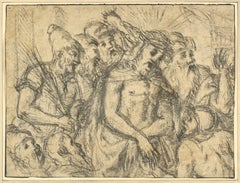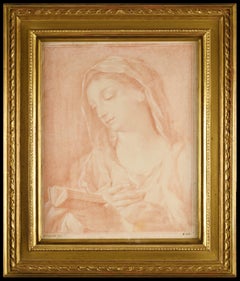18th Century and Earlier Figurative Drawings and Watercolors
Old Masters 18th Century and Earlier Figurative Drawings and Watercolors
Chalk
Old Masters 18th Century and Earlier Figurative Drawings and Watercolors
Chalk, Ink
Old Masters 18th Century and Earlier Figurative Drawings and Watercolors
Chalk
18th Century and Earlier Figurative Drawings and Watercolors
Handmade Paper, Chalk
Modern 18th Century and Earlier Figurative Drawings and Watercolors
Ink, Pastel, Watercolor
Old Masters 18th Century and Earlier Figurative Drawings and Watercolors
Ink
Baroque 18th Century and Earlier Figurative Drawings and Watercolors
Paper, Chalk
Modern 18th Century and Earlier Figurative Drawings and Watercolors
Watercolor, Pencil
Old Masters 18th Century and Earlier Figurative Drawings and Watercolors
Ink
Modern 18th Century and Earlier Figurative Drawings and Watercolors
Pencil
Renaissance 18th Century and Earlier Figurative Drawings and Watercolors
Handmade Paper
Mannerist 18th Century and Earlier Figurative Drawings and Watercolors
Oil, Canvas, Handmade Paper
Baroque 18th Century and Earlier Figurative Drawings and Watercolors
Handmade Paper
Old Masters 18th Century and Earlier Figurative Drawings and Watercolors
Carbon Pencil
Old Masters 18th Century and Earlier Figurative Drawings and Watercolors
Ink, Handmade Paper, Laid Paper
Modern 18th Century and Earlier Figurative Drawings and Watercolors
Pencil
Baroque 18th Century and Earlier Figurative Drawings and Watercolors
Handmade Paper
Other Art Style 18th Century and Earlier Figurative Drawings and Watercolors
Pencil, Paper
Baroque 18th Century and Earlier Figurative Drawings and Watercolors
Ink, Laid Paper
Baroque 18th Century and Earlier Figurative Drawings and Watercolors
Handmade Paper
Italian School 18th Century and Earlier Figurative Drawings and Watercolors
Handmade Paper, Ink, Graphite
18th Century and Earlier Figurative Drawings and Watercolors
Watercolor, Mezzotint
English School 18th Century and Earlier Figurative Drawings and Watercolors
Ink
Italian School 18th Century and Earlier Figurative Drawings and Watercolors
Handmade Paper, Ink, Graphite
Old Masters 18th Century and Earlier Figurative Drawings and Watercolors
Paper
Rococo 18th Century and Earlier Figurative Drawings and Watercolors
Handmade Paper
18th Century and Earlier Figurative Drawings and Watercolors
Mezzotint, Watercolor
18th Century and Earlier Figurative Drawings and Watercolors
Mezzotint, Watercolor
Old Masters 18th Century and Earlier Figurative Drawings and Watercolors
Handmade Paper, Ink, Laid Paper
18th Century and Earlier Figurative Drawings and Watercolors
Mezzotint, Watercolor
Modern 18th Century and Earlier Figurative Drawings and Watercolors
Pencil
18th Century and Earlier Figurative Drawings and Watercolors
Mezzotint, Watercolor
18th Century and Earlier Figurative Drawings and Watercolors
Mezzotint, Watercolor
18th Century and Earlier Figurative Drawings and Watercolors
Mezzotint, Watercolor
Old Masters 18th Century and Earlier Figurative Drawings and Watercolors
Paper, Chalk
Old Masters 18th Century and Earlier Figurative Drawings and Watercolors
Oil
Realist 18th Century and Earlier Figurative Drawings and Watercolors
Watercolor, Ink, Laid Paper, Pen
Romantic 18th Century and Earlier Figurative Drawings and Watercolors
Crayon, Handmade Paper
Italian School 18th Century and Earlier Figurative Drawings and Watercolors
Handmade Paper, Ink
Old Masters 18th Century and Earlier Figurative Drawings and Watercolors
Ink
Baroque 18th Century and Earlier Figurative Drawings and Watercolors
Paper, Crayon
Naturalistic 18th Century and Earlier Figurative Drawings and Watercolors
Handmade Paper, Ink
Modern 18th Century and Earlier Figurative Drawings and Watercolors
Etching, Watercolor
Old Masters 18th Century and Earlier Figurative Drawings and Watercolors
India Ink
Baroque 18th Century and Earlier Figurative Drawings and Watercolors
Ink, Chalk, Paper, Clay
Old Masters 18th Century and Earlier Figurative Drawings and Watercolors
Pen, Ink
Old Masters 18th Century and Earlier Figurative Drawings and Watercolors
Paper
18th Century and Earlier Figurative Drawings and Watercolors
Watercolor
18th Century and Earlier Figurative Drawings and Watercolors
Watercolor
18th Century and Earlier Figurative Drawings and Watercolors
Watercolor
Modern 18th Century and Earlier Figurative Drawings and Watercolors
Pencil
Old Masters 18th Century and Earlier Figurative Drawings and Watercolors
Pen, Ink
Academic 18th Century and Earlier Figurative Drawings and Watercolors
Pastel, Paper, Pencil
Realist 18th Century and Earlier Figurative Drawings and Watercolors
Watercolor
Romantic 18th Century and Earlier Figurative Drawings and Watercolors
Paper, Cardboard
Modern 18th Century and Earlier Figurative Drawings and Watercolors
Watercolor, Paper
Modern 18th Century and Earlier Figurative Drawings and Watercolors
Ink
Old Masters 18th Century and Earlier Figurative Drawings and Watercolors
Chalk




